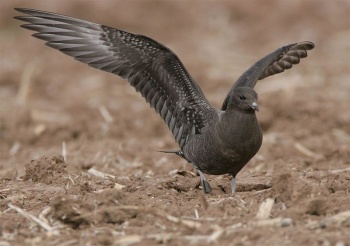Alternative name: Long-tailed Skua
- Stercorarius longicaudus
Identification
Length 50–55 cm (19¾-21¾ in); (including tail projection of 12–24 cm), wingspan 105–112 cm, weight 230–350 g

Photo © by Steve McDonnell
Goswick, Lindisfarne, Northumberland, 30 September 2017
Adult
- The smallest, and often the scarcest jaeger (skua)
- Light grey-brown upperparts
- Creamy white breast, with yellow flush on throat and cheeks
- Grey belly
- Black cap (which covers eyes and chin and ends at yellow nape
- Upperwings dark-edged
- Primaries blackish, except for white shaft only on outermost two primaries
- Dark grey tail with black edges and very long, flexible black streamers
- Blue-grey legs with webbed feet
- Bill black; short and stubby compared to other jaegers
- Sexes similar. Dark morph (similar to dark morph Parasitic Jaeger except in structure) known, but extremely rare, only a handful of records ever.
Juvenile has much shorter tail streamers than adult, but still longer than those of other juvenile jaegers; streamer tips broad, rounded. Bill grey with a dark tip. Three morphs, varying in darkness:
- Pale morph is extensively pale grey, often with a nearly white head; only flight feathers (primaries, secondaries, rectrices) dark
- Intermediate morph is heavily barred and spotted grey with white patches on underwings, white throat, white belly
- Dark morph juvenile is much darker overall, with grey throat, and without white belly; only a few pale bars on under-tail coverts
Distribution
Breeds on arctic tundra of far northern areas from northern Europe (Norway eastwards), through most of arctic Asia, and Alaska, northern Canada, and Greenland.
Migration usually well offshore, but can be seen in good numbers at a few oceanic headlands, such as Ard an Runair on North Uist, Scotland.
Winters at sea, primarily between 50–60°S latitude, south of the coasts of South Africa, southern South America and Australia and New Zealand[2].
Taxonomy
Subspecies
Two subspecies are recognised[1]:
- S. l. longicaudus
- S. l. pallescens
- Breeds northern North America and north-eastern Asia (white-headed juveniles are more common in this subspecies).
Habitat
Nests on Arctic tundra. Spends winters over open ocean mainly near upwelling zones at the edge of the continental shelfs, usually staying offshore, and very rarely found inland. However, in migration, and especially in central and northern Europe, a juvenile jaeger found inland on barren tundra should be considered a Long-tailed until proven otherwise.
Behaviour
Diet
During the summer their main diet consists of lemmings.
Breeding
Breeding is reliant upon the availability of lemmings, its principal summer food, in almost the entire breeding range.
Vocalisation
References
- Clements, J. F., T. S. Schulenberg, M. J. Iliff, S. M. Billerman, T. A. Fredericks, B. L. Sullivan, and C. L. Wood. 2019. The eBird/Clements Checklist of Birds of the World: v2019. Downloaded from http://www.birds.cornell.edu/clementschecklist/download/
- Del Hoyo, J, A Elliot, and J Sargatal, eds. 1996. Handbook of the Birds of the World. Volume 3: Hoatzin to Auks. Barcelona: Lynx Edicions. ISBN 978-8487334207
- Collins Field Guide 5th Edition
- Birdforum thread discussing ID of a dark juvenile
- Furness, R.W., Kirwan, G.M., de Juana, E. & Garcia, E.F.J. (2019). Long-tailed Jaeger (Stercorarius longicaudus). In: del Hoyo, J., Elliott, A., Sargatal, J., Christie, D.A. & de Juana, E. (eds.). Handbook of the Birds of the World Alive. Lynx Edicions, Barcelona. (retrieved from https://www.hbw.com/node/53960 on 22 August 2019).
Recommended Citation
- BirdForum Opus contributors. (2025) Long-tailed Jaeger. In: BirdForum, the forum for wild birds and birding. Retrieved 30 April 2025 from https://www.birdforum.net/opus/Long-tailed_Jaeger
External Links
GSearch checked for 2020 platform.1







